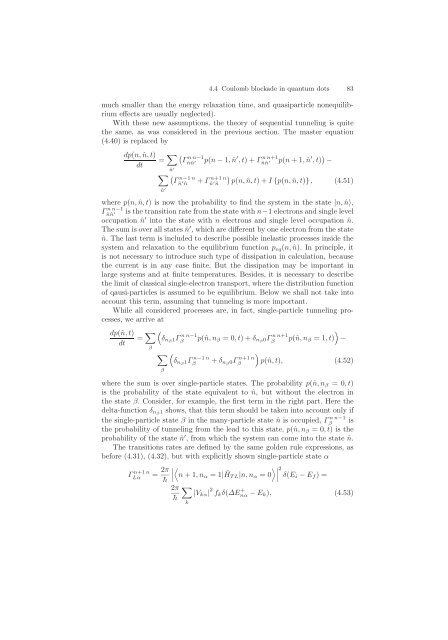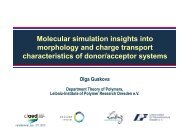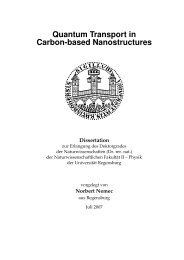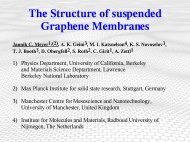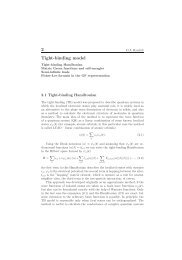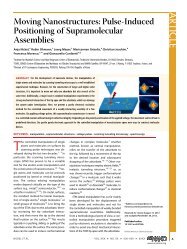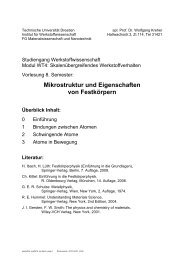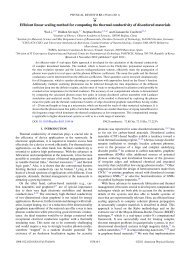4 Coulomb blockade
4 Coulomb blockade
4 Coulomb blockade
Create successful ePaper yourself
Turn your PDF publications into a flip-book with our unique Google optimized e-Paper software.
4.4 <strong>Coulomb</strong> <strong>blockade</strong> in quantum dots 83<br />
much smaller than the energy relaxation time, and quasiparticle nonequilibrium<br />
effects are usually neglected).<br />
With these new assumptions, the theory of sequential tunneling is quite<br />
the same, as was considered in the previous section. The master equation<br />
(4.40) is replaced by<br />
dp(n, ˆn, t)<br />
=<br />
dt<br />
<br />
ˆn ′<br />
nn−1<br />
Γˆnˆn ′ p(n − 1, ˆn ′ ,t)+Γ nn+1<br />
ˆnˆn ′ p(n +1, ˆn ′ ,t) −<br />
n−1 n<br />
Γˆn ′ n+1 n<br />
ˆn + Γˆn ′ <br />
ˆn p(n, ˆn, t)+I {p(n, ˆn, t)} , (4.51)<br />
ˆn ′<br />
where p(n, ˆn, t) is now the probability to find the system in the state |n, ˆn〉,<br />
Γ nn−1<br />
is the transition rate from the state with n−1 electrons and single level<br />
ˆnˆn ′<br />
occupation ˆn ′ into the state with n electrons and single level occupation ˆn.<br />
The sum is over all states ˆn ′ , which are different by one electron from the state<br />
ˆn. The last term is included to describe possible inelastic processes inside the<br />
system and relaxation to the equilibrium function peq(n, ˆn). In principle, it<br />
is not necessary to introduce such type of dissipation in calculation, because<br />
the current is in any case finite. But the dissipation may be important in<br />
large systems and at finite temperatures. Besides, it is necessary to describe<br />
the limit of classical single-electron transport, where the distribution function<br />
of qausi-particles is assumed to be equilibrium. Below we shall not take into<br />
account this term, assuming that tunneling is more important.<br />
While all considered processes are, in fact, single-particle tunneling pro-<br />
cesses, we arrive at<br />
dp(ˆn, t)<br />
=<br />
dt<br />
<br />
β<br />
<br />
δnβ1Γ<br />
δnβ1Γ nn−1<br />
β<br />
β<br />
p(ˆn, nβ =0,t)+δnβ0Γ nn+1<br />
<br />
β p(ˆn, nβ =1,t) −<br />
n−1 n<br />
β<br />
+ δnβ0Γ<br />
n+1 n<br />
β<br />
<br />
p(ˆn, t), (4.52)<br />
where the sum is over single-particle states. The probability p(ˆn, nβ =0,t)<br />
is the probability of the state equivalent to ˆn, but without the electron in<br />
the state β. Consider, for example, the first term in the right part. Here the<br />
delta-function δnβ1 shows, that this term should be taken into account only if<br />
the single-particle state β in the many-particle state ˆn is occupied, Γ nn−1<br />
β is<br />
the probability of tunneling from the lead to this state, p(ˆn, nβ =0,t)isthe<br />
probability of the state ˆn ′ , from which the system can come into the state ˆn.<br />
The transitions rates are defined by the same golden rule expressions, as<br />
before (4.31), (4.32), but with explicitly shown single-particle state α<br />
n+1 n 2π<br />
<br />
<br />
ΓLα = n +1,nα =1|<br />
¯h<br />
ˆ 2 <br />
HTL|n, nα =0 δ(Ei − Ef) =<br />
2π <br />
|Vkα|<br />
¯h<br />
2 fkδ(∆E + nα − Ek), (4.53)<br />
k


